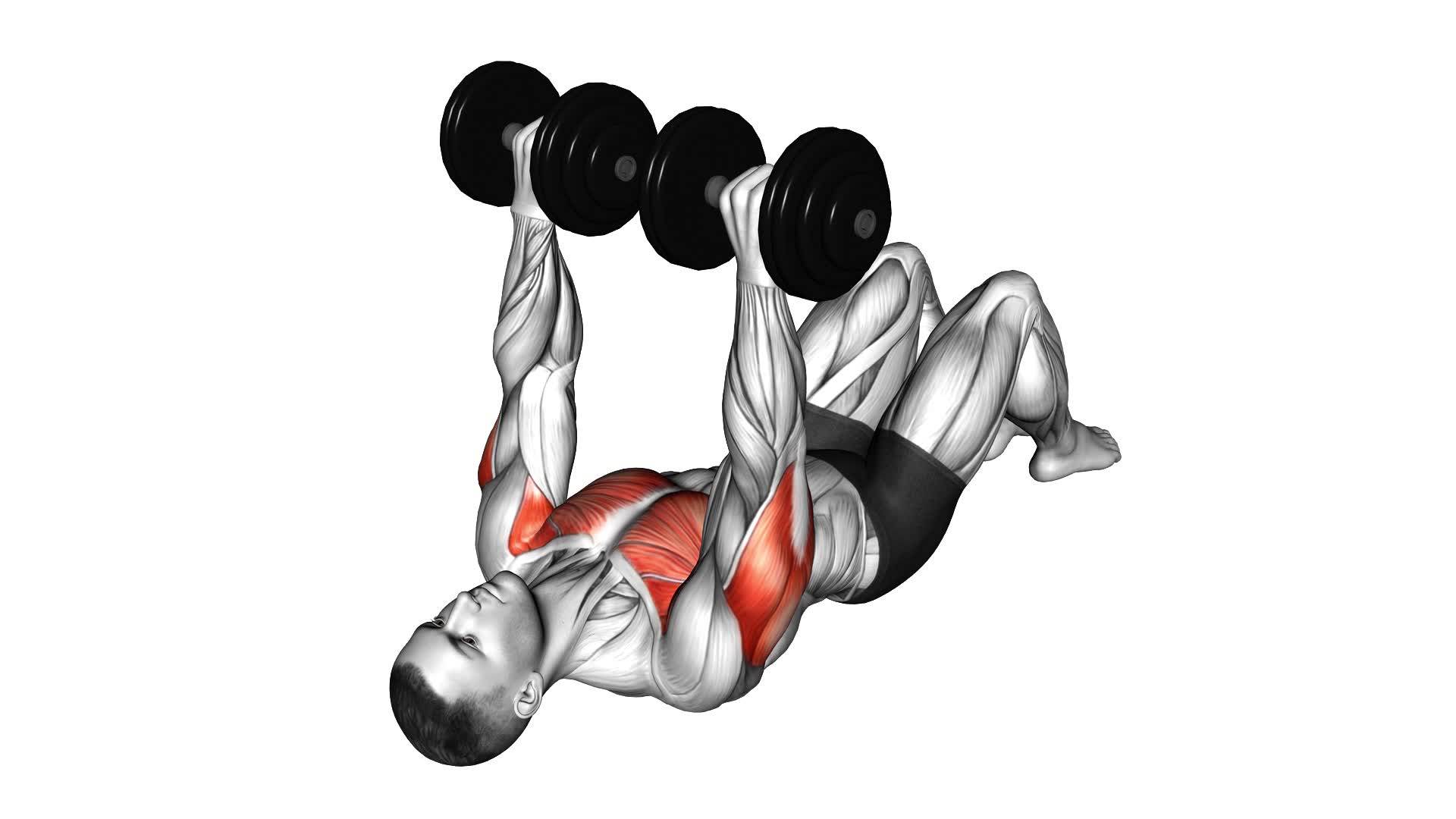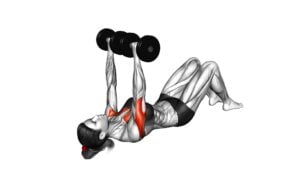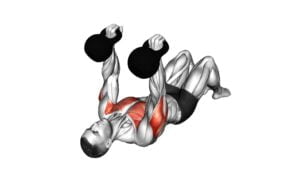Dumbbell Lying on Floor Chest Press – Video Exercise Guide & Tips

Are you looking for an effective chest exercise that you can do at home? Look no further than the dumbbell lying on floor chest press.
Watch This Exercise Video
This exercise targets your chest muscles and can help you build strength and definition. In this article, we'll guide you through the proper form and technique, help you choose the right weight and equipment, and provide tips for maximizing your results.
Get ready to level up your chest workout with this simple yet powerful exercise.
Key Takeaways
- The dumbbell lying on floor chest press targets chest muscles efficiently and improves upper body strength and stability.
- It is important to maintain proper form and technique, such as lying flat on the back with knees bent and feet flat on the floor, and avoiding arching the back or lifting hips off the floor.
- When choosing weights and equipment, opt for comfortable and easy to control dumbbells, select a weight that challenges muscles without compromising form, and gradually increase weight as strength improves.
- Common mistakes to avoid include arching the back, excessive stress on joints by keeping a slight bend in the elbows, relying on momentum instead of using a controlled tempo, and maintaining proper hand position to prevent strain on the wrists.
Benefits of the Dumbbell Lying on Floor Chest Press
To maximize your chest strength and muscle development, you can benefit from incorporating the dumbbell lying on floor chest press into your workout routine. This exercise offers numerous benefits that can help you achieve your fitness goals more effectively.
One of the main advantages of the dumbbell lying on floor chest press is that it targets your chest muscles more efficiently compared to other chest exercises. By lying flat on the floor, you eliminate the need for stabilizing muscles, allowing you to solely focus on your chest muscles.
This exercise also helps improve your upper body strength and stability, as it engages your shoulder and tricep muscles as well. Additionally, the dumbbell lying on floor chest press offers variations that can further enhance your workout routine.
You can adjust the weight of the dumbbells, the angle of your arms, or even perform the exercise with one arm at a time to add variety and challenge.
Incorporating the dumbbell lying on floor chest press into your workout routine can provide you with a highly effective way to strengthen and develop your chest muscles.
Proper Form and Technique for the Exercise
Mastering the proper form and technique for the dumbbell lying on floor chest press is essential for maximizing the effectiveness of this exercise. To ensure you're performing the exercise correctly, start by lying flat on your back with your knees bent and feet flat on the floor. Hold a dumbbell in each hand, positioning them just above your chest with your palms facing forward. Press the dumbbells upward, extending your arms fully while maintaining control. Lower the dumbbells back down to the starting position, allowing your elbows to lightly touch the floor before repeating the movement.
Common errors to watch out for include arching your back or lifting your hips off the floor. Keep your core engaged and your back flat throughout the exercise. Additionally, avoid locking your elbows at the top of the movement to prevent unnecessary strain on the joints.
There are variations and modifications you can incorporate to target different muscle groups or accommodate any physical limitations. For instance, you can perform the exercise with a single dumbbell or use a barbell instead. If you have shoulder issues, you can decrease the range of motion by stopping before your elbows touch the floor. Remember to always consult with a fitness professional to determine the best variations or modifications for your specific needs.
Choosing the Right Weight and Equipment
To ensure you choose the appropriate weight and equipment for the dumbbell lying on floor chest press, consider your current strength level and fitness goals. Equipment selection is crucial for this exercise, as it can greatly impact your form and overall performance.
When it comes to choosing the right equipment, opt for dumbbells that are comfortable to grip and easy to control. The weight selection is equally important. It should be challenging enough to stimulate muscle growth, but not too heavy that it compromises your form. Start with a weight that allows you to perform the exercise with proper technique and gradually increase the weight as you get stronger. It's important to listen to your body and make adjustments accordingly.
Common Mistakes to Avoid During the Exercise
To avoid common mistakes during the dumbbell lying on floor chest press exercise, focus on maintaining proper form and technique. Here are some tips to help you avoid injuries and maximize the effectiveness of the exercise:
- Avoid arching your back: Keep your spine in a neutral position throughout the movement to prevent strain on your lower back.
- Don't lock your elbows: Keep a slight bend in your elbows to avoid placing excessive stress on the joint.
- Use a controlled tempo: Avoid using momentum to lift the dumbbells. Instead, focus on a slow and controlled movement to engage your chest muscles effectively.
- Maintain proper hand position: Make sure your wrists are aligned with your elbows and shoulders to prevent strain on your wrists.
- Don't lift too heavy: It's better to use lighter weights with proper form than to use a weight that's too heavy and compromise your technique.
If you find the dumbbell lying on floor chest press too challenging or if you want to switch up your routine, here are some alternatives to consider:
- Push-ups: This bodyweight exercise targets your chest muscles and can be modified to suit different fitness levels.
- Chest press machine: Using a chest press machine provides stability and allows you to focus on your chest muscles without worrying about balance.
- Resistance bands: These versatile bands can be used to simulate the chest press motion and provide resistance for your muscles.
Tips for Maximizing Your Results
To maximize your results in the dumbbell lying on floor chest press exercise, focus on proper form and technique. This will ensure that you're targeting the chest muscles effectively and minimizing the risk of injury. Here are some tips to help you maximize your results:
- Maintain proper form: Keep your back flat against the floor and your core engaged throughout the exercise. This will help you maintain stability and prevent any unnecessary strain on your back.
- Use an appropriate weight: Start with a weight that allows you to perform the exercise with proper form. As you progress, gradually increase the weight to continue challenging your muscles.
- Control the movement: Lower the dumbbells slowly and with control, and then press them back up explosively. This will engage your chest muscles more effectively and maximize your results.
- Incorporate nutrition tips: To optimize your results, ensure that you're fueling your body with the right nutrients. Consume a balanced diet that includes lean proteins, healthy fats, and carbohydrates to support muscle growth and recovery.
- Modify the workout: If you find the exercise too challenging or if you have any physical limitations, you can modify the exercise by using lighter weights or performing the exercise on an incline bench instead.
Frequently Asked Questions
How Many Sets and Reps Should I Do for the Dumbbell Lying on Floor Chest Press?
For the dumbbell lying on floor chest press, you may be wondering how many sets and reps you should do.
This exercise can be beneficial for various muscle groups, including your chest, shoulders, and triceps.
To determine the number of sets and reps, it's best to consult with a fitness professional or trainer who can tailor a program to your specific needs and goals.
They can ensure you're performing the exercise correctly and safely while maximizing its benefits.
Can I Do This Exercise if I Have Shoulder or Wrist Injuries?
If you have shoulder or wrist injuries, modifications can be made for the dumbbell lying on floor chest press.
For shoulder injury modifications, you can try using lighter weights or resistance bands to reduce strain.
For wrist injury modifications, you can use wrist wraps or modify the grip to alleviate discomfort.
It's important to consult with a healthcare professional or a qualified trainer to ensure proper form and prevent further injury.
Is It Necessary to Have a Spotter While Performing the Dumbbell Lying on Floor Chest Press?
When performing the dumbbell lying on floor chest press, you might wonder if having a spotter is necessary.
Well, having a spotter can have several benefits. They can provide assistance if you struggle with the weights, ensuring your safety.
A spotter can also help you maintain proper form and prevent any potential injuries. Remember, it's always better to be safe than sorry, so consider having a spotter while doing this exercise.
Can This Exercise Help in Building Overall Chest Strength or Is It More Focused on Specific Muscles?
The dumbbell lying on floor chest press is a great exercise for building chest strength. It targets your chest muscles and helps to develop overall chest strength.
This exercise allows you to fully engage and activate your chest muscles, leading to better muscle growth and strength.
Are There Any Variations or Modifications of the Dumbbell Lying on Floor Chest Press That I Can Try?
When it comes to variations and modifications of the dumbbell lying on floor chest press, there are a few options you can try. These can include using different grip variations, such as a neutral grip or a pronated grip.
You can also experiment with using different weights or adding in pauses at different points of the exercise. These variations can help target different areas of the chest and add variety to your workout routine.
Conclusion
In conclusion, the dumbbell lying on the floor chest press is a highly effective exercise for strengthening and toning the chest muscles. By maintaining proper form and technique, choosing the appropriate weight, and avoiding common mistakes, you can maximize your results.
Incorporating this exercise into your workout routine can help you achieve your fitness goals and improve your overall upper body strength.

Author
Years ago, the spark of my life’s passion ignited in my mind the moment I stepped into the local gym for the first time. The inaugural bead of perspiration, the initial endeavor, the very first surge of endorphins, and a sense of pride that washed over me post-workout marked the beginning of my deep-seated interest in strength sports, fitness, and sports nutrition. This very curiosity blossomed rapidly into a profound fascination, propelling me to earn a Master’s degree in Physical Education from the Academy of Physical Education in Krakow, followed by a Sports Manager diploma from the Jagiellonian University. My journey of growth led me to gain more specialized qualifications, such as being a certified personal trainer with a focus on sports dietetics, a lifeguard, and an instructor for wellness and corrective gymnastics. Theoretical knowledge paired seamlessly with practical experience, reinforcing my belief that the transformation of individuals under my guidance was also a reflection of my personal growth. This belief holds true even today. Each day, I strive to push the boundaries and explore new realms. These realms gently elevate me to greater heights. The unique combination of passion for my field and the continuous quest for growth fuels my drive to break new ground.







